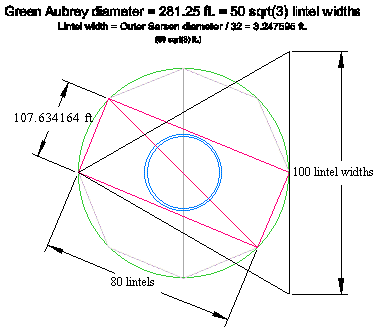Megalithic Yard Unearthed | home
Megalithic Yard Surprises | Was Thom misled? | Woodhenge | Stonehenge and Sarsen circle | The Lintel Circle | Hawkins' Photogrammetry | Trilithon ellipse | Megalithic Foot and Megalithic Inch | Arcs, chords & sagitta | Pi-Pyramid and the Megalithic Yard | Map Scales | Miles and the Equator | Additions, Vara etc. | Contact Me | CALCULATOR
Hawkins' Photogrammetry
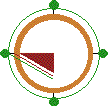 The geometry on the previous pages, now needs to be tested on an accurate plan of stonehenge.
The geometry on the previous pages, now needs to be tested on an accurate plan of stonehenge. The best one I could find was one in a book on my shelf, "Beyond Stonehenge" by Gerald S. Hawkins, (Arrow edition 1977). Following on from his best seller "Stonehenge Decoded", he returned to the Henge, acquired the services of Hunting Surveys who ran a photogrammetric survey, and came up with the following plan. (See his chapter 4, 'A New Map', pages 51 et seq.). The method he says is '...... accurate, absolute, unambiguous, mechanically final'.
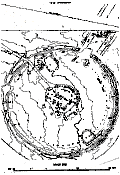 The page was scanned into a Turbocad proramme.
The page was scanned into a Turbocad proramme.The most accurate and regular circle is that of the Aubrey Holes, a reasonable place to start. This was the first circle to be estimated and drawn as nearly as possible with the equipment I have, and it's centre determined (Red cross)
Stage 2. Draw in the octagon, and extend the sides to form a square (blue).
"" 3. Circumscribe the square with a red circle
"" 4. Follow up with an escribed square (blue), and another outer circle .(red).
Everything in Black is Hawkins original, anything coloured is my addition.
Note that the oblique line at the top is a true bearing of 120° 50' 47", so the page is not due North and South, nor the avenue correctly aligned, but this does not affect the superimposed geometry.
What was unexpected, was how the majenta line from the centre intersected the Heel Stone circle at just the spot where an extended Ditch square line met, together with the Black Hawkins base line.
The Green line from the Sarsen circle centre, was in line and focused upon a small cross marked on Hawkins 120° course line, and thus acts as a kind of check that my construction must be reasonably accurate.
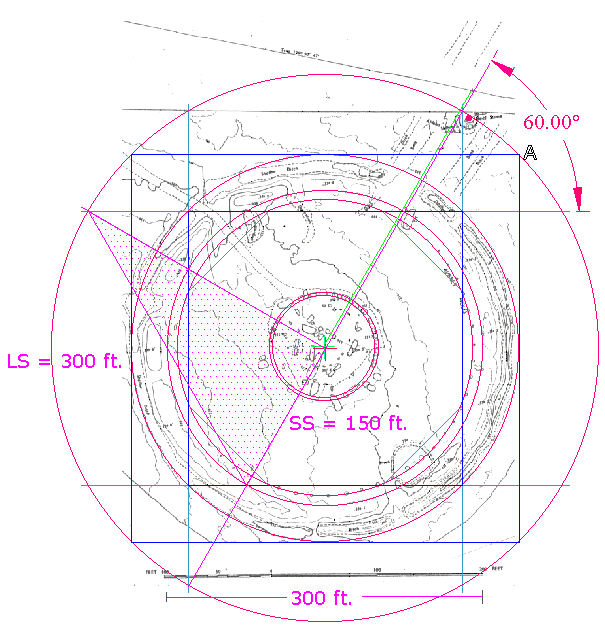
If the rings and squares were to be swivelled around, say move 'A' to the Heel Stone, the Station Stone rectangle would be square on to the Axis, then the whole lot could be adjusted to align the axis to wherever it is supposed to be. The Geometry would not be affected.
I have constructed and hatched in my basic 30°/ 60° triangle onto the Heel Stone circle, whose diameter is found to be 519.6152 feet, thus giving an SS of 150 feet. and an LS of 300 ft. (Odd that Hawkins scale should be 300 ft. long!).
Another point to note, is that the radius of the outer Sarsen circle is 51.96 ft., 1/10 th Heel Stone diameter. Thus the dimensions of the Sarsen circle were determined way back in an earlier Stage, and the sight lines from the Station stones did not constrain and limit it's size.
The Heel Stone circle just touches the outer edge of the Stone itself, and is 600 MY in circumference.
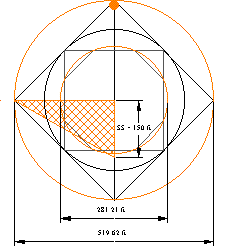
Here is the basic figure.
On this small scale the geometric construction is accurate. Measurements may not quite match up with published data, as the match I fitted to the Aubrey ring may be a little short at 281.21ft. diameter, (but this might be to the inside edge of the holes), whereas a diameter of 282.74 ft. would have an SS of 30 MY. , and the preferred measure is some 283+ ft. However, the overall design is quite remarkable.
Now, the perimeter of the sqrt 3 triangle of the Sarsen Circle, is 30+60+51.96 = 141.962 ft., just about the radius of the Aubrey circle. Rodney Castleden, 'The making of Stonehenge', page 68, (and see fig.23, page 55), says the diameter of a wooden post circle at the centre of Stonehenge 1, was 82 ft.
Eighty two feet could also be the SS of a triangle drawn within the Aubrey circle, giving a radius of 142.028 feet. The difference of the two lengths (141.962 and 142.02) is less than 0.8 inches.
The circumference of the Aubrey Circle would then be 82 x 4 or 328 Meg Yards.
However, if the radius of the Aubrey circle is taken to be 141.96152 ft. (the perimeter length of the Sarsen 30/60 triangle), then the Aubrey diameter minus the Sarsen outer diameter, is exactly 180 feet.
BUT ..... When the figure is drawn accurately, from an SS of 150ft., the rectangle (Station Stone) perimeter is exactly Ten times the length of the side of the inscribed Sarsen square.(73.484 ft.).
Half the rectangle perimeter is the Ditch diameter. (367.4235 ft.)
Long side of the perimeter is Heel stone radius (80 lintel widths).
Ditch square perimeter is Ten times the Sarsen diameter. (103.923 ft.)
HOWEVER .... if the geometric diameter of the Aubrey (to the inner edge of the pits) is 281.21372
